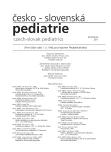Thromboembolism events in the newborn child from the point of view of present medicine
Authors:
M. Grešíková
Authors‘ workplace:
Klinika detskej hematológie a onkológie, Detská fakultná nemocnica s poliklinikou, Bratislava
prednosta doc. MUDr. E. Kaiserová, CSc.
Published in:
Čes-slov Pediat 2011; 66 (5): 299-307.
Category:
Review
Overview
The incidence of thrombosis in childhood is very low in comparison to the adult population. Venous and arterial thromboses are rare diseases, being increasingly recognised and diagnosed not only in infants but also in newborns and premature newborns. Newborns, particularly the premature ones, are rather predisposed to bleeding complications due to the special properties of haemostatic system. Therefore every thrombotic event is a potentially serious condition which requires adequate diagnostic and therapeutic approach. It is very probable that most thromboembolic events occur in children, which have certain prothrombotic risk or may have met it. Acquired risk factors such as central vascular approaches, sepsis, perinatal infection and congenital heart defects are applied more frequently than congenital thrombophilic factors, with a smaller population incidence.
The following article describes the causes, clinical presentation and current management of thrombosis in neonates focusing on the clinically most relevant conditions.
Key words:
thrombosis, neonate, antitrombotic treatment
Sources
1. Raffini L, Huang YSh, Witmer Ch, et al. Dramatic increase in venous thromboembolism in children´s hospitals in the United States from 2001 to 2007. Pediatrics 2009; 124 : 1001–1008.
2. Journeycake JM. Thrombosis in infancy and childhood. In: Colman RW, Marder VJ, Clowes AW, George JN, Goldhaber SZ. Hemostasis and Thrombosis. Basic Principles and Clinical Practice. 5th ed. Philadelphia: Lippincott Williams and Wilkins, 2006 : 1637–1647.
3. Monagle P, Chalmers E, Chan A, et al. Antitrombotic therapy in neonate and children. American College of Chest Physicians Evidence – based clinical practice guidelines, 8th ed. Chest 2008; 133(Suppl): 887S–968S.
4. Lanzkowsky Ph. Thrombosis disorders. In: Manual of Pediatric Hematology and Oncology. 5th ed. London, Burlington, San Diego: Elsevier, 2011 : 419–440.
5. Bernard TJ, Goldenberg NA. Pediatric arterial ischemic stroke. Pediatr Clin N Amer 2008; 55 : 323–338.
6. Trenor CC, Michelson AD. Thrombophilia and pediatric stroke. Circulation 2010; 121 : 1838–1847.
7. Fischer D, Porto L, Stoll H, et al. Intracerebral mass bleeding in a term neonate: manifestation of hereditary protein S deficiency with a new mutation in the PROS1 gene. Neonatology 2010; 98 : 337–340.
8. Boffa MC, Lachassinne E. Review: infant perinatal thrombosis and antiphospholipid antibodies: a review. Lupus 2007; 16 : 634–641.
9. Renaud C, Bonneau Ch, Presles E, et al. Lipoprotein (a), birth weight and neonatal stroke. Neonatology 2010; 98 : 225–228.
10. Srinivasan J, Miller S, Phan TG, et al. Delayed recognition of initial stroke in children: need for increased awareness. Pediatrics 2009; 124 :e227–e234.
11. Hirsh J. Antithrombotic therapy in neonates and children. In: Guidelines for Antitrombotic Therapy. 8th ed. Hamilton: 2008 : 140–149.
12. Olosová A, Chovancová D, Drobná H, et al. Liečba heparínom u novorodencov a detí. Čes-slov Pediat 2004; 59 : 152–159.
13. Grešíková M. Zásady antitrombotickej liečby u novorodencov a detí. Pediatria 2010; 1 : 44–49.
14. Leary SE, Harrod VL, deAlarcon PA, et al. Low-dose systemic thrombolytic therapy for deep vein thrombosis in pediatric patients. J Pediat Hematol/Oncol 2010; 32 : 97–102.
15. Harney KM, McCabe M, Branowicki P, et al. Observation cohort study of pediatric in patients with central venous catheters at „intermediate risk“ of thrombosis and eligible for anticoagulant prophylaxis. J Pediat Oncol Nursing 2010; 27 : 325–329.
16. Revel-Vilk Sh. Central venous line-related thrombosis in children. Acta Haematol 2006; 115 : 201–206.
17. Shahr L, Boehlen F, de Moerloose Ph, et al. Anticoagulants in portal vein thrombosis: don´t be so shy! Blood 2009; 113 : 5031–5032.
18. Lam HS, Li AM, Chu WCW, et al. Mal-positioned umbilical venous catheters causing liver abscess in a preterm infant. Neonatology 2005; 88 : 54–56.
19. Sharathkumar AA, LaMear N, Pipe S, et al. Management of neonatal aortic arch thrombosis with low-molecular weigth heparin: a case series. J Pediat Hematol/Oncol 2009; 31 : 516–521.
20. Winyard PJD, Bharucha T, deBruyn R, et al. Perinatal renal venous thrombosis: presenting renal length predicts outcome. Arch Dis Child Fetal Neonatal Ed 2006; 91: F273–F278.
21. Lee J, Croen LA, Backstrand KH, et al. Maternal and infant characteristics associated with perinatal arterial stroke in the infant. JAMA 2005; 293 : 723–729.
22. Roach ES, Golomb MR, Adams R, et al. Management of stroke in infants and children. Stroke 2008; 39 : 2644–2691.
23. Bernard TJ, Goldenberg NA, Tripputi M, et al. Anticoagulation in childhood-onset arterial ishcemic stroke with non-moyamoya arteriopathy. Stroke 2009; 40 : 2869–2871.
24. Lee J, Croen LA, Lindan C, et al. Predictors of outcome in perinatal arterial stroke: a population-based study. Ann Neurol 2005; 58 : 303–308.
25. Perkins E, Stephens J, Xiang H, et al. The cost of pediatric stroke acute care in the United States. Stroke 2009; 40 : 2840.
26. Pappachan J, Kirkham FJ. Cerebrovascular disease and stroke. Arch Dis Child 2008; 93 : 890–898.
27. Blatný J, Penka M, Štěrba J. Trombóza v dětském věku – důvod k vyšetření? Čes-slov Pediat 2002; 57 : 375–377.
28. Grešíková M. Aký je medicínsky racionálny postup v odhaľovaní trombofílie u detí? Lek Obz 2011; 3 : 136–141.
29. Poul H, Kessler P. Trombofilní stavy: význam pro prevenci a léčbu žilního tromboembolizmu. Vnitř Lék 2009; 5 : 242–252.
Labels
Neonatology Paediatrics General practitioner for children and adolescentsArticle was published in
Czech-Slovak Pediatrics

2011 Issue 5
- What Effect Can Be Expected from Limosilactobacillus reuteri in Mucositis and Peri-Implantitis?
- The Importance of Limosilactobacillus reuteri in Administration to Diabetics with Gingivitis
Most read in this issue
- Thromboembolism events in the newborn child from the point of view of present medicine
- The effect of mouth breathing on splanchnocraniums development in childhood
-
Influence of passive exposure to cigarette smoke on health and development of children in prenatal and postnatal period to 7 years of age.
Results of ELSPAC Study - Quality of life in children with allergic rhinitis
